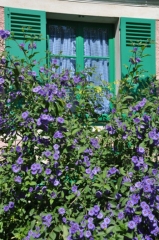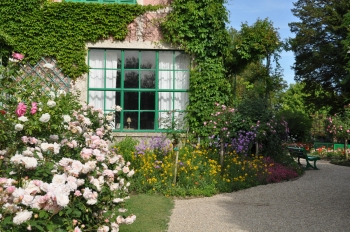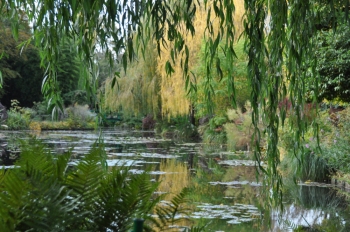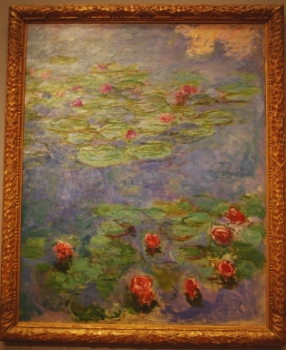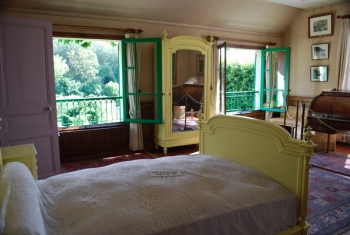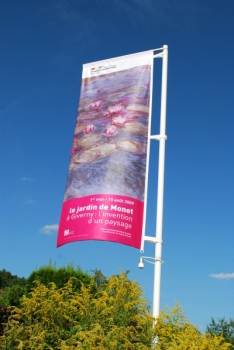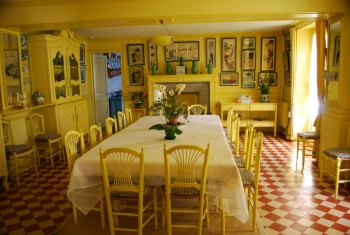January 12, 2015
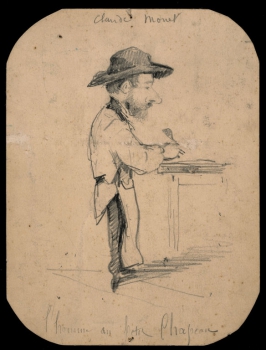
Claude Monet, ‘L’homme au petit chapeau’ (The Man in the Small Hat) 1855/56, Art Institute of Chicago.
Monet started his career as a caricaturist. The Art Institute of Chicago keeps one of his most ancient drawings, this man in a small hat made when he was 15 years old. Because the title is so vague and the drawing rather respectful, we can imagine that this young person may have been Monet’s school mate. Later on, Monet became more offending by drawing what was not yet called the people of Le Havre, as we say in French: the upper middle class bourgeoisie of his city.
I must say this is not the Monet I like best. But it reflects the impulsive and rebellious personality of the painter. Twenty years later, it was Monet’s turn to be mocked, when he dared show his avant garde paintings at the first impressionist exhibition in Paris.
This is how liberty goes. Monet and his friends opened new fields of liberty. The freedom to paint how I like, what I like. The freedom to exhibit and find buyers.
But Monet wanted more. Later on Monet still fought for the admission of Manet’s ‘Olympia’ in the state collections. He didn’t paint for a year to dedicate to this mission. He wanted public recognition of this new freedom.
In matter of politics, Monet was not the kind of artist that withdraws in one’s studio. He was friend with Zola and supported him during the Dreyfus Affair, because he felt things were not fair and had much to do with anti-semitism.
This is how he lived, secluded in the village of Giverny but reading the newspapers, keeping an eye on the world, speaking with Clemenceau.
Monet would have been Charlie.
Posted in Claude Monet No Comments »
December 27, 2014
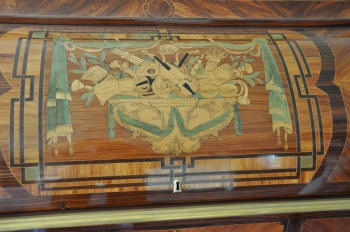
Here is a close-up of the desk that can be seen in Claude Monet’s bedroom at Giverny. It is from the mid 18th Century and features music instruments, not painting material. It was already an antique when Monet purchased it.
During the second half of his life Monet became famous. Recognised as a great painter, he sold his paintings at high prices. This enabled him to live a comfortable life.
The desk was restored last winter and found its original colors again.
Posted in Giverny, Claude Monet, Monet's House No Comments »
September 6, 2013
According to Claude Monet’s step son Jean-Pierre Hoschedé, the painter loved blue flowers.
This beautiful solanum, a plant belonging to the family of tomatoes and potatoes, is covered with simple little blue flowers.
It matches the colors of the kitchen window with its blue squared curtains, a very typical french pattern called vichy fabric.
In late Summer, plants are at the top of their heigth. With a bit of imagination, the flowers of the Giverny garden look like big waves splashing against the walls of the house.
Posted in Monet's House, Monet's flower garden No Comments »
August 29, 2013
The large window of Monet’s first studio at Giverny looks like an eye scrutinizing the flowers of the garden in order to paint them.
It opens onto the little rose garden, a corner that is rarely explored by the visitors of Giverny.
See two posts below the view from the inside, giving the illusion of a painting.
Posted in Giverny, Monet's House No Comments »
April 19, 2012
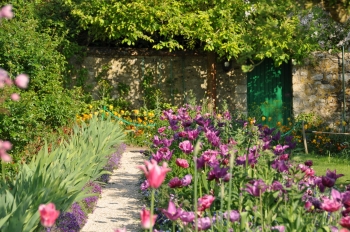 One of the charms of Monet’s flower garden is its countryside look. This secluded garden is surrounded by high stone walls typical for the backyards in the region of Giverny. While the houses open on to the streets, the walls are pierced by little wooden doors leading to narrow paths between the estates. In Monet’s flower garden, this one was the way to the cottage of the head gardener in Monet’s times.
One of the charms of Monet’s flower garden is its countryside look. This secluded garden is surrounded by high stone walls typical for the backyards in the region of Giverny. While the houses open on to the streets, the walls are pierced by little wooden doors leading to narrow paths between the estates. In Monet’s flower garden, this one was the way to the cottage of the head gardener in Monet’s times.
Against the walls, espaliered pear and apple trees recall the former use of the garden as an orchard, before Monet turned it into a magnificent impressionist garden. The straight alleys look like those of the kitchen garden it used to be.
Posted in Monet's flower garden No Comments »
January 2, 2012
 Best wishes
Best wishes
from Giverny
for a splendid
year 2012
full of light
and beauty!
Posted in Giverny, Water-Garden No Comments »
December 21, 2011
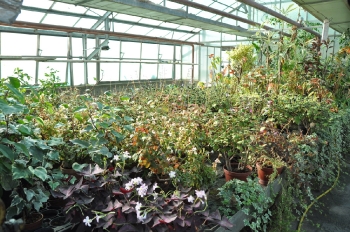 Are you curious to have a look inside of Monet’s greenhouse, that is not open to the public?
Are you curious to have a look inside of Monet’s greenhouse, that is not open to the public?
I was! With the allowance of the gardener, I took this picture last July.
Even in Summer many plants need to be kept inside. Some of them will decorate the house, others will be used to adornate the meeting rooms when VIPs come to Giverny, others are waiting for being planted, others are mother plants…
Monet was such a keen gardener that he built a greenhouse on the location of this one, on the left side of the flower garden. It was heated, and the painter cultivated orchids and exotic ferns. He also grew his seedlings in the greenhouse.
Posted in Monet's flower garden 2 Comments »
December 2, 2011
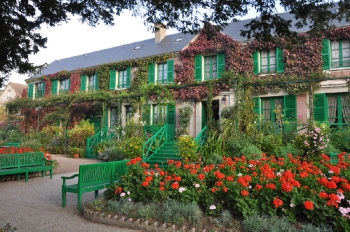 Flashing reds and greens in the soft light of October, this is what Monet’s garden offers in October in the area in front of the painter’s house.
Flashing reds and greens in the soft light of October, this is what Monet’s garden offers in October in the area in front of the painter’s house.
The “Monet green” spreads on benches, shutters, stairs… creating a strong contrast with the formal geranium beds and the virginia creeper on the façade.
Posted in Monet's House No Comments »
November 10, 2011
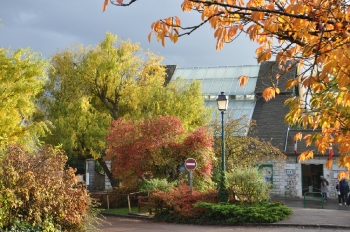 Monet was 76 when he decided he needed a new studio. This one is actually the third one he built on the premises.
Monet was 76 when he decided he needed a new studio. This one is actually the third one he built on the premises.
After having turned a former barn with western light into his first studio, errected the second one with a big window on the northern facade, Monet decided he wanted the light to fall from the sky, and not from any other direction.
This is why the third studio has huge skylights. The entire roof is made out of glass.
Posted in Monet's House 1 Comment »
January 27, 2011
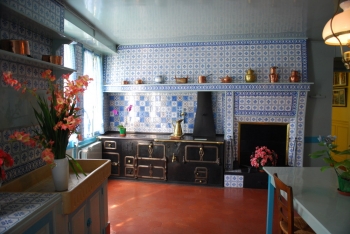 Very striking in Claude Monet’s kitchen at Giverny are the blue tiles that cover all the walls.
Very striking in Claude Monet’s kitchen at Giverny are the blue tiles that cover all the walls.
Posted in Monet's House 9 Comments »
November 8, 2010
In his water garden at Giverny, Claude Monet planted tall trees like weeping willows, ash trees, chestnut trees, poplars, copper beeches…
They were underplanted by shrubs that offered their interesting foliages, flowers, berries, and scents: roses, tree peonies, azaleas, rhododendrons, viburnums, Japanese maples, ferns…
These shrubs were underplanted by flowers, for example flag irises, to provide a touch of vibrant color.
Thus, Monet created a little world that resembled a clearance in the woods.
He liked to feel blended with nature. Staring at the reflections of the sky into the pond, he could loose any notion of himself and merge into the waterscape.
Posted in Water-Garden No Comments »
February 22, 2010
The Palace of the Legion of Honor in San Francisco surprises French visitors by the words written on the pediment of the main entrance : Honneur et Patrie. Surprises continue with its beautiful collection of European art including five gorgeous Monets.
The biggest one faces visitors at the end of a perspective through several large rooms. It deserves this honor. This enormous canvas of Monet’s late period, painted during World War One, is certainly one of the most splendid masterpieces of the museum.
Monet focuses on two patches of water lilies floating on the pond in his garden at Giverny. Unlike many of the paintings in this series, this canvas is very bright. Vibrant reds and pinks pop out the flowers, contrasting with the soft greens of the lily pads and the pale blue of the reflected sky. Curiously enough, a cotton like cloud occupies the upper corner of the painting, when it should be reflected at the lower part of the canvas. It is one of Monet’s favorite game to mix all the landmarks to create confusion in the eyes of the viewer.
Posted in Monet Painting No Comments »
September 19, 2009
A detail strikes the visitors who enter Monet’s bedroom at Giverny: the bed is ridiculously small.
Claude Monet wasn’t very tall, and he didn’t share his bed with his wife. They had separate bedrooms. Not because they didn’t care, but rich families copied the aristocracy and had separate ‘appartements’, though they were connected.
Monet could get up very early without waking his wife. He loved to paint before sunrise, when the river is still covered with mist.
The bed and the armoire, which were not very expensive furniture, were painted according to Monet’s taste.
Monet had gorgeous views over his garden from his bedroom’s three windows. The painter designed his bedroom, he had it built just over the first studio. He wanted a lot of light in it.
The bedroom was the place where he hung his collection of impressionist paintings by his friends, an incredible collection of 35 canvases including 12 paintings by Cézanne, many Renoirs, Sysleys, Morisots, Manets and so on.
The desk is a beautiful antique from the 18th century.
Posted in Claude Monet, Monet's House 7 Comments »
August 13, 2009
Over 100 000 visitors will have seen the beautiful exhibition of 28 paintings by Monet at the Musee des Impressionnismes Giverny.
The exhibition started on May 1st ends on Saturday 15 August.
It will have met all the expectations by attracting crowds of Monet lovers in the village where the canvases, mostly featuring Nympheas, had been created.
The next exhibition opening on 23 August is dedicated to the oversized and colorful paintings of American artist Joan Mitchell. Joan Mitchell, a master of expressionism, was inspired by Monet’s Nympheas. She lived for years in Vetheuil, her studio neighboring Monet’s house on the river side.
For the museum, it will be sort of a flash-back to its origins. Before becoming the Musee des Impressionnismes Giverny, it used to be the Musee d’Art Americain Giverny.
Posted in Giverny, Claude Monet, Impressionism Museum 1 Comment »
August 2, 2009
I have just been given the right to take pictures inside of Monet’s House. I am thrilled being able to comment on this very special home I love!
Taking photographs in the museum is forbidden for several reasons, especially because of the very fragile japanese woodblocks that hang on the walls. Monet didn’t want his own work to decorate his home: it was work! He preferred something more exotic and fun. He would hang them everywhere except in his studio, in the kitchen and in his bedroom.
I don’t know what strikes visitors most when they enter the most beautiful room of the house, the famous dining room. The Japanese prints cover the walls, almost masking them, their mainly blue color matching the yellow furniture, walls and moldings.
It is strangely modern, especially when compared with the very heavy and dark fashion in matter of decoration in Victorian times. Bright, and stunning. Everybody says waow! when stepping inside of this yellow dining room, and most people like it. But for some visitors, it is too yellow.
Posted in Monet's House 11 Comments »

